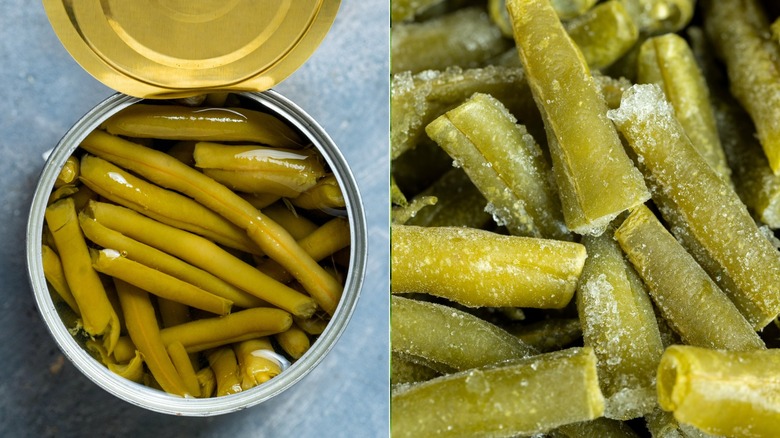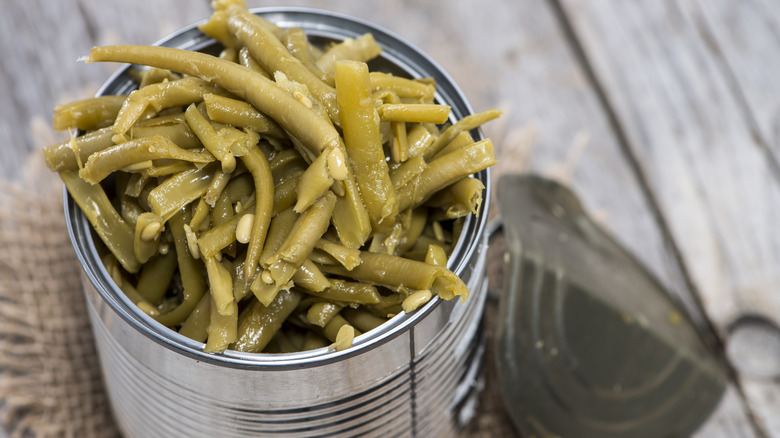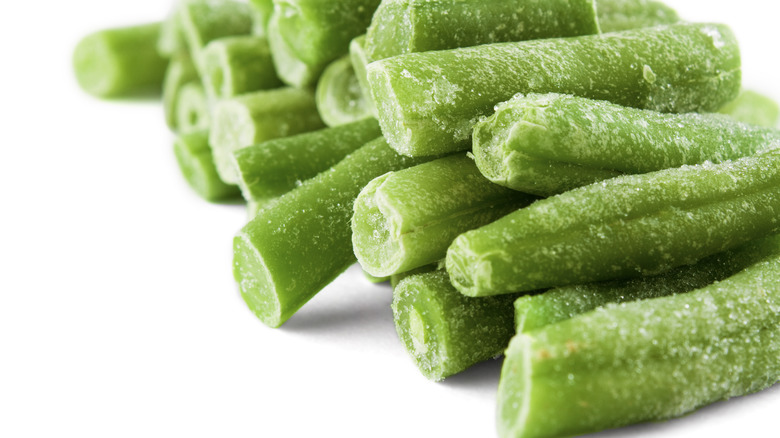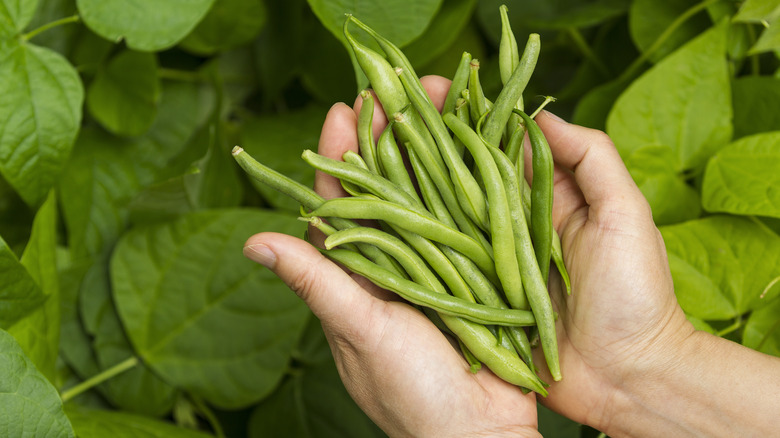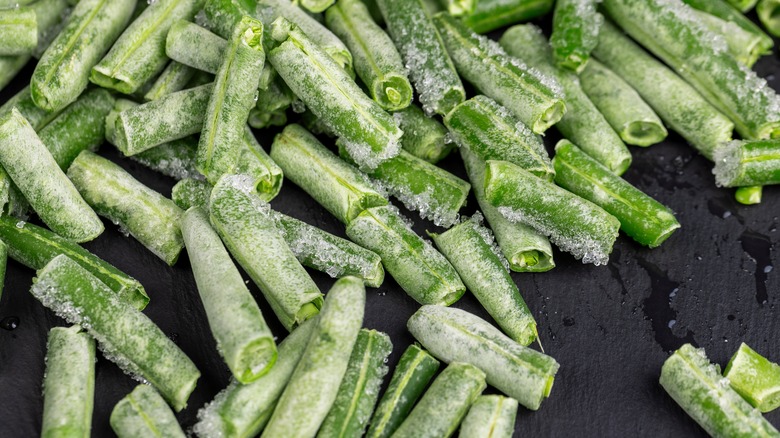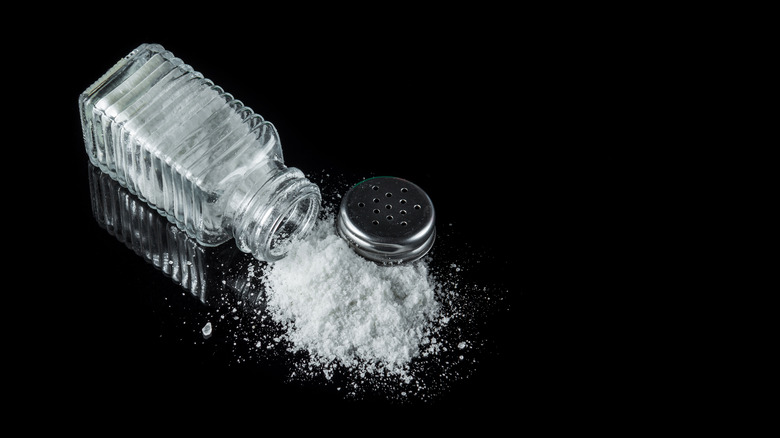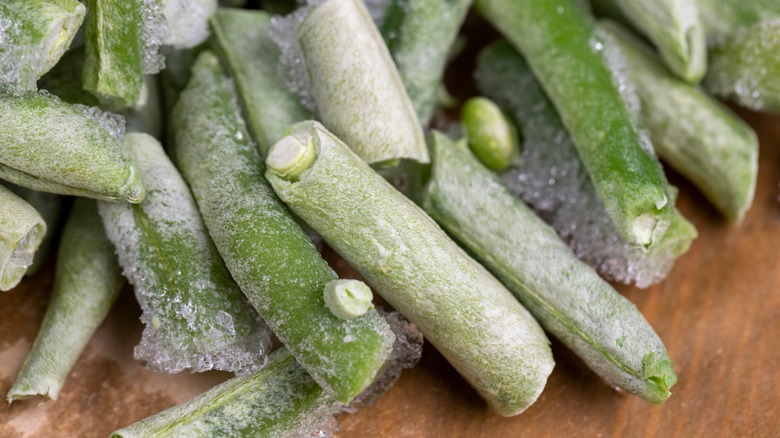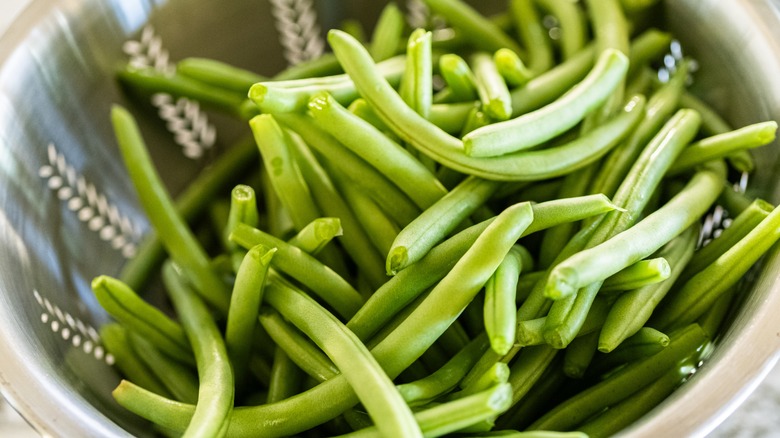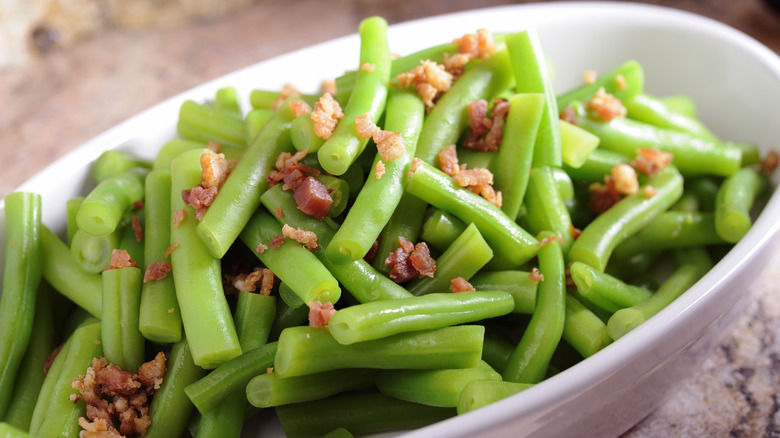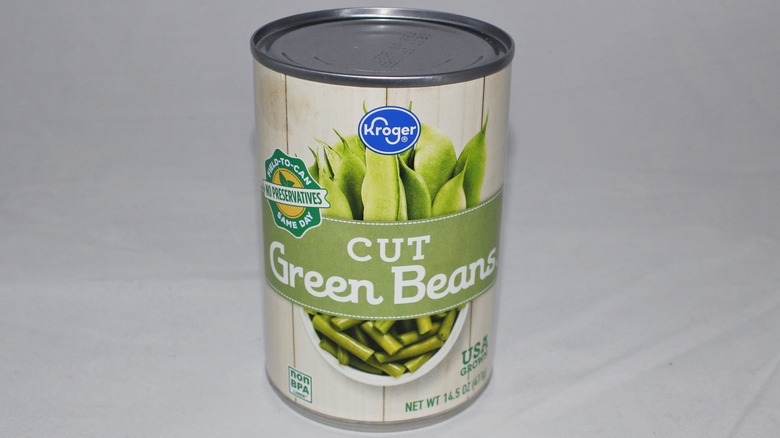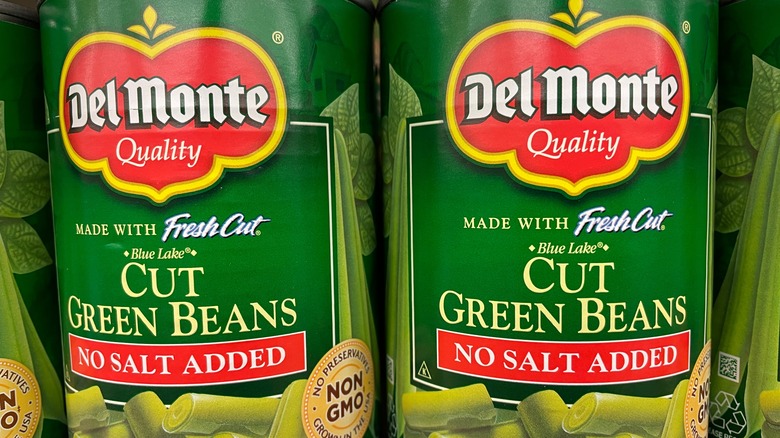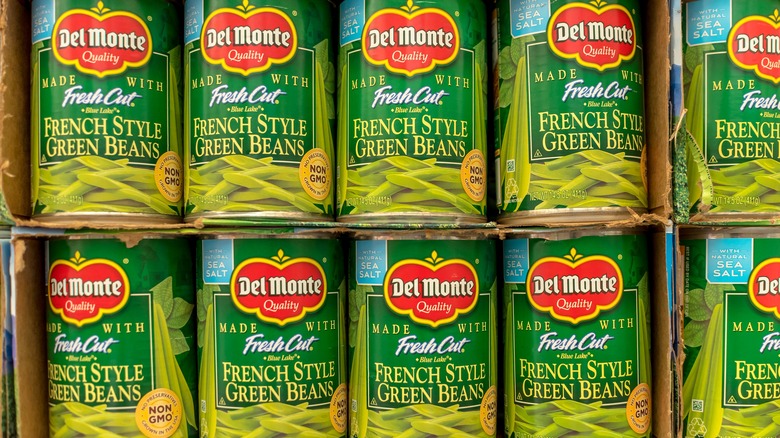Canned Vs Frozen Green Beans: What's The Difference?
The snap of fresh green beans is so satisfying to hear when prepping your meals, as well as the sizzles that arise from the pan when you toss them in with a generous dab of butter and a dash of salt. But not everyone has time to painstakingly trim the ends, and then cut up the vegetables into small pieces. We don't always remember to grab a bunch of fresh green beans at the supermarket, and might kick ourselves when we don't have the perfect veggie side dish for that garlic butter steak and potato skillet dinner.
This is why it pays to have a few cans of green beans in the pantry, or slip a bag of frozen green beans in the freezer. But what are the differences between the two? Which should you have in your home? While they're both certainly the same ingredient, there are some things that might make one better than the other for you.
What are canned green beans?
Canned green beans are cut and preserved green beans in a metal can. They don't need to be refrigerated or frozen — once you buy them, they can be stored safely in your kitchen at room temperature. This is thanks to the canning technology developed centuries ago.
The green beans are first harvested at their prime, washed, snipped, and cut. They're then blanched and cooled, which not only preserves their fresh taste, but also kills bacteria. Next, after sorting, they're put into a can with either water or brine — some have additional seasoning too. Because they're preserved in a liquid, canned green beans have a softer texture when compared to fresh green beans.
Because they're so versatile, canned green beans can be used for a variety of recipes. Typically, you'll find them in casseroles, stuffings, soups, and stews. If you're after a good recipe, then try our spruced-up green bean casserole recipe.
What are frozen green beans?
Frozen green beans are cut and preserved green beans too, but through a different method. As the name implies, frozen green beans need to be kept in the freezer, but they aren't just harvested, cut, and frozen immediately. Instead, these vegetables go through a slightly more sophisticated process of rapid freezing. This technology was developed back in the 1920s by American businessman Clarence Birdseye, who was inspired by how Inuits preserved their foods. He used two refrigerated metal plates to freeze foods quickly, which helped to preserve their taste.
You can use frozen green beans in many of the same dishes you'd use canned green beans in, but frozen green beans outshine their canned counterparts when it comes to sautéing. Because they're basically like fresh green beans, you can toss them with a little butter and salt, put the pan on high heat, and get deliciously crispy green beans as a side for dinner.
They're preserved using different methods
Both products are harvested at peak season, ensuring that consumers get the freshest green beans possible. In addition, the veggies are blanched before the actual preservation process, which helps lock in both flavor and texture by inactivating enzymes. But this is where the similarities end.
A British broker named Peter Durand is credited with the first patent for canning in 1810. However, his idea wasn't original! Several years prior to Durand's patent, French chef Nicolas Appert was already "canning" foods, but with glass jars instead. Durand basically took this idea and switched the glass part to tin cans. The idea was a hit, and just three years after the patent, manufacturer Hall and Gamble started churning out canned goods. Basically, after blanching, the green beans are put into the can with liquid (water or brine), the lid is sealed on, and the entire can is heated to kill bacteria. Finally, the can's ready for sale after rapid cooling.
Frozen green beans go through a simpler procedure. After blanching, they're subject to three stages — pre-freezing, freezing, and reduction to storage temperature. All this happens within seconds, thanks to tech such as quick freezer machines. Rapid freezing minimizes the presence of ice crystals, which compromise the quality of food. Also, while canned green beans have water or brine added, frozen green beans have no other additions.
Frozen green beans typically have more nutrients
The nutritional difference between fresh and canned green beans is pretty negligible. The same goes for frozen green beans, which is great. This means that you don't have to feel bad when serving canned or frozen green beans to your family — even though both preservation methods result in some nutrient loss, it's not enough to make a noticeable difference in your diet.
However, if you want to get into the nitty-gritty, the frozen option wins in most cases if you're looking for the maximum vitamins and minerals. For example, frozen beans have more provitamin A carotenoids than canned green beans do. On the other hand, the canning process has no loss of ascorbic acid (vitamin C), unlike with freezing. The same goes for storage, as canned green beans retain more nutrients more than their frozen counterpart. Canned green beans do beat frozen for folate levels, but it's such a small difference in comparison to how frozen wins by almost double the nutrient levels for thiamin, riboflavin, and vitamin B6.
Canned green beans can be saltier
Take a look at the canned green beans in your pantry, and there's a good chance you'll see salt listed as one of the ingredients on the back. This is because the veggies are preserved with liquid, and the usual choices are plain water or brine. And brine is, by definition, full of salt. However, frozen green beans are blanched, and then quickly frozen without any other ingredients or liquid. This means that if you're avoiding sodium in your diet, frozen beans will usually be the safer bet.
Those watching their salt intake don't necessarily have to avoid canned green beans though. While in the grocery store, you can search for the "no sodium added" options. Or if you already have the cans in your house, you can rinse the canned beans in a strainer. This can eliminate a decent amount of salt and keep your intake low.
Frozen green beans are crunchier
We get it — people have different preferences for textures, so while one person may prefer crunchy green beans, another will like them soft and mushy. The fact of the matter is that frozen green beans are definitely crunchier, and this comes down to the methods used to preserve the vegetables. The canning process requires the green beans to go through high-heat processing and then they're preserved in liquid. Typically, it's hard for any ingredient to stay crunchy if it's immersed in liquid, and this is definitely true for green beans.
Frozen green beans retain a firmer texture since they're immediately frozen after blanching. Plus, they're not swimming in liquid, which means it's easier for the veggies to not go limp. As long as you don't defrost them before you cook them, then frozen green beans will be crunchier than canned, even after cooking. With this information, you can make the right choice when trying different recipes. For instance, canned green beans are great for a casserole, since it's a baked dish with a mix of ingredients in a warm gooey pile. Crunchiness doesn't matter there!
Frozen green beans taste closer to fresh green beans
As we mentioned earlier, canned green beans have a mushier texture. While this isn't the taste of the green beans itself, the mouthfeel can certainly affect how you perceive the actual flavor. When you put a spoonful of canned green beans into your mouth, you can immediately tell it's not fresh, even without looking at it. In addition, it has a slightly off taste — there may be a metallic zing from the can. Frozen green beans are kept in plastic bags, so there's no chance of that extra flavor sneaking in.
Also, both types of green beans can be seasoned to your liking. However, it's easier to do so with frozen green beans since you can season them freely while cooking. Canned usually comes in a brine, so it's tougher to get the salt to a specific level. And if you want to avoid the canned green beans becoming like baby food, you have to add them in at the end of cooking, giving less time to absorb the flavor of any seasonings.
Frozen green beans are more customizable
Both green bean options can be mixed with other vegetables, making a great medley for any meal. But the ingredients for frozen green beans are just the beans themselves, while canned green beans have brine included. Also, canned green beans are very soft and limp. As a result, you're more limited in recipe choices since you usually can't substitute them for fresh green beans.
On the other hand, frozen green beans can pretty much be treated like fresh ones, as long as you cook them straight from frozen. If you try thawing them, this will make them almost as soggy as canned green beans. For example, let's say you want to try the surprisingly good pairing of green beans and anchovies — you'd cook the frozen green beans straight from the freezer so they retain their crunch and provide a nice contrast to the soft anchovies.
Canned green beans are more convenient
Canned green beans are much more convenient in comparison to frozen. For one, you can eat them right out of the can after opening the top. With frozen green beans, you'll have to heat them up first or settle for green bean popsicles. So when you're in a rush to throw together dinner, you'll want canned green beans on your side. We will admit, though, that a great shortcut is to throw frozen ones in a bowl for nuking in the microwave!
Also, canned green beans can be stored for long periods in the pantry, without much worry about them. They'll live happily with other shelf-stable items. Frozen green beans will take up freezer space, which you probably have less of in comparison to your spacious pantries. Plus, you'll have to rotate the items out more often, making frozen green beans less of a "throw in and forget about" item.
Canned green beans are usually cheaper
At face value, you'll see that canned green beans are usually cheaper than frozen vegetables. However, are they actually the more affordable option when you consider the yield after prepping and cooking the green beans? Well, you'll be happy to know that canned green beans still come out on top when factoring those things in!
In 2022, the USDA found that the average prices of fresh, canned, and frozen green beans were $2.62, $1.13, and $2.00 per pound respectively. As you can see, canned green beans proved to be the most affordable choice already. Accounting for the preparation yield factor and size of a cup equivalent, then calculating the average price-per-cup equivalent (with the liquid drained for the canned product), the results were $0.85 (fresh), $0.52 (canned), and $0,66 (frozen). Ultimately, you'll still save the most money with canned green beans, which is good to know when you're on a tight budget.
Canned green beans last longer
Yes, products come with "best by" dates, but if you don't like to waste food, then you'll be pleased to know that with proper storage, both canned and frozen green beans can last a good long while. However, the winner for longevity is canned green beans. If you put yours in a cool and dry place, and there are no defects in the cans, then your green beans will keep up to five years. If you spot and bulges, leaks, or severe dents though, then always throw out those cans, to be safe. After you open a can, store any leftovers in a glass or plastic container to put in the refrigerator for up to four days.
Frozen green beans, on the other hand, will stay good for up to around a year. Once you've opened the bag, the chances of freezer burn attacking your beans will increase, and the longer you store the bag, the higher the chances of freezer burn as well. While freezer burn won't pose a risk to your health, it can affect how the green beans look and taste. So we'd recommend eating your frozen green beans before the "best by" date.
